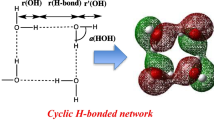Abstract
Energy band structures of one-dimensional (HF)n- and (H2O)n-chains have been calculated (1) by extrapolation of CNDO/2-MO levels to infinite chain length and (2) by the CNDO/2 crystal orbital (CO) method. In the CO-calculations interactions up to fifth neighbours have been taken into account. Both types of calculations were performed using experimental geometries and CNDO/2 minimum geometries of the corresponding dimers (HF)2 and (H2O)2. With the same geometries CO calculations on two-dimensional sheets of hydrogen bonded chains were performed too.
Due to end-effects the extrapolated MO bands are much broader than the bands obtained by the CO method. In the CO calculations further neighbour interactions play a non-negligible role and hence the nearest neighbour approximation is not sufficient for an accurate description of crystals containing hydrogen bonds.
MO calculations on one-dimensional chains of both systems show that the hydrogen bond energies increase with the number of monomers indicating the presence of cooperative effects. The hydrogen bond energies calculated with the CO method are usually somewhat larger than those extrapolated from the MO results. In three-dimensional networks of (H2O)n, however, the additional stabilization of clusters with respect to dimers is drastically diminished.
Similar content being viewed by others
References
DelBene,J., Pople,J.A.: J. Chem. Phys. 52, 4858 (1970)
Hankins,D., Moskowitz,J.W., Stillinger,F.H.: Chem. Phys. Letters 4, 527 (1970).—J. Chem. Phys. 53, 4544 (1970)
Kollman,P.A., Allen,L.C.: J. Am. Chem. Soc. 92, 753 (1970)
DelBene,J., Pople,J.A.: J. Chem. Phys. 55, 2296 (1971)
Bacon,J., Santry,D.P.: J. Chem. Phys. 55, 3743 (1971)
Bacon,J., Santry,D.P.: J. Chem. Phys. 56, 2011 (1972)
DelRe,G., Ladik,J., Biczò,G.: Phys. Rev. 155, 997 (1967)
Ladik,J., Biczò,G.: Acta Chim. Hung. 67, 397 (1971)
Pople,J.A., Santry,D.P., Segal,G.A.: J. Chem. Phys. 43, S 129, S 136 (1965)
Pople,J.A., Segal,G.A.: J. Chem. Phys. 44, 3289 (1966)
Pople,J.A., Beveridge,D.L.: Approximate molecular orbital theory. New York: McGraw Hill 1970
Eisenberg,D., Kauzman,W.: The structure and properties of water, p. 74. Oxford: Clarendon Press 1969
Schuster,P.: Theoret. Chim. Acta (Berl.) 19, 212 (1970)
Murrell,J.N., Harget,A.J.: Semiempirical SCF-MO theory of molecules, p. 89. London: Wiley-Interscience 1972
Atoji,M., Lipscomb,W.N.: Acta Cryst. 7, 173 (1954)
Suhai,S., Ladik,J.: Theoret. Chim. Acta (Berl.) 28, 27 (1972)
Ladik,J., Rai,D.K., Appel,K.: J. Mol. Spectry. 27, 79 (1968)
Author information
Authors and Affiliations
Rights and permissions
About this article
Cite this article
Karpfen, A., Ladik, J., Russegger, P. et al. Hydrogen bonding in long chains of hydrogen fluoride and long chains and large clusters of water molecules. Theoret. Chim. Acta 34, 115–127 (1974). https://doi.org/10.1007/BF00551362
Received:
Issue Date:
DOI: https://doi.org/10.1007/BF00551362



